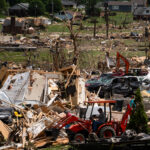The California electric grid operator Monday called on additional power plants to be ready to run as a deadly wildfire expanded near Los Angeles, increasing the threat to high-voltage power lines serving the city.
The Los Angeles Department of Water and Power (LADWP) asked customers to limit electric use Monday as the fire raging in the Angeles National Forest has the potential to damage two 500-kilovolt lines northeast of the Acton area, the municipal utility said in a release.
Those 500-kv lines are critical to importing a steady supply of power into Los Angeles, LADWP said. The agency has activated its power plants in the area in the event more generation is needed.
“The threat to these lines, combined with the typical high energy demand on hot days, makes it even more necessary that all customers make every effort to reduce their energy demand,” the agency said.
The Station fire doubled to nearly 86,000 acres (35,000 hectares) over night, officials said.
Over the weekend, as many as five power lines in Southern California were knocked out by the fire for at least some period of time, but no electric service was disrupted, said Gregg Fishman, a spokesman for the California Independent System Operator.
No lines were affected by the fire Monday afternoon, Fishman said.
“Still, the potential is there,” he said. “We are monitoring the situation very closely.”
The grid operator has called on additional power plants across the state to be ready to step in to supply electricity should transmission be affected, Fishman said.
Meanwhile, many areas of the state continue to experience above-normal temperatures, boosting normal August power needs.
The Cal ISO system, which transmits about 80 percent of the electricity used in California, expects power demand to peak at 42,600 megawatts today and 43,370 MW on Tuesday.
Today’s high in Los Angeles is forecast to reach 95 degrees Fahrenheit (35 Celsius), 11 degrees above normal for late August.
One megawatt in Southern California can serve about 650 average households but fewer homes during periods of high heat when demand soars.
(Reporting by Eileen O’Grady; Editing by Christian Wiessner)
Was this article valuable?
Here are more articles you may enjoy.

 Two Chevron Workers Die of Injuries From Angola Platform Fire
Two Chevron Workers Die of Injuries From Angola Platform Fire  Trump Administration Targets Resiliency Funds to Shrink FEMA’s Role
Trump Administration Targets Resiliency Funds to Shrink FEMA’s Role  Fixing the Claims Experience Where It Matters Most: In the Mess
Fixing the Claims Experience Where It Matters Most: In the Mess  Delivery Hero Hit by $376 Million Fine for Glovo Cartel
Delivery Hero Hit by $376 Million Fine for Glovo Cartel 